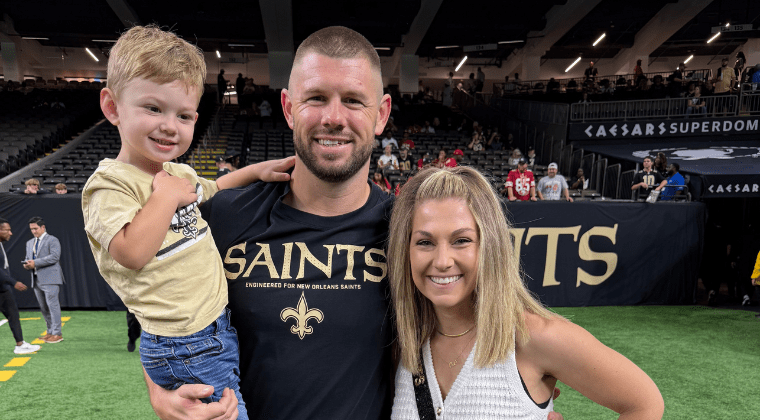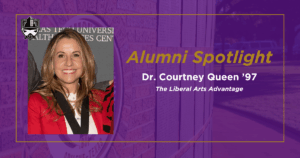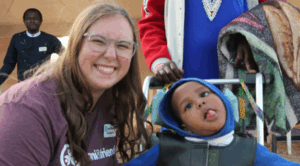From HSU Graduate Program to the New Orleans Saints
Luke Lancaster ’19 used his Master of Science in Kinesiology, Sport and Recreation from Hardin-Simmons University to build a career as an assistant strength and conditioning coach with the New Orleans Saints.

The alarm sounds at 4 a.m. in Covington, Louisiana. Luke Lancaster ’19 pours a cup of coffee, steps into the dark, and starts the 45-minute drive across the 24-mile Lake Pontchartrain Causeway
“I usually try to work out first thing in the morning,” he says. “That’s kind of my peace. It helps reset everything and gets my mind ready for the day.”
By the time the sun breaks over the water, the New Orleans Saints’ weight room hums with the sound of barbells. Lancaster moves through his own workout before the players arrive — a daily rhythm that centers him before the intensity of the day.
“There’s a structure to it,” he says. “That structure has carried me through a lot of seasons in my life.”
Lancaster grew up in Maryville, Missouri, a town of 10,000 where football was king and strength and conditioning wasn’t yet a career path.

Luke Lancaster, Hardin-Simmons University alumnus and New Orleans Saints assistant strength and conditioning coach, poses for a photo with his family.
“I fell in love with the weight room because I wasn’t a great football player,” he says. “That’s where I found my lane. I didn’t even know strength and conditioning was a real job at first.”
As his coaching career grew, so did his ambition. He knew he needed a graduate degree to reach his next goal.
“Early on, I realized I wanted to be a director, a head strength coach,” he says. “A master’s degree was the standard, but it was also personal. Nobody in my family had ever done that.”
Online programs were easy to find. But Lancaster wasn’t looking for easy.
“School doesn’t come naturally to me,” he admits. “I want to be able to reach out to my professors. I like being face-to-face.”
After a conversation with Dr. Ruot, he found the right fit in Hardin-Simmons University’s graduate program.
“I just remember thinking, this is it. This is where I need to be,” he says.
By the time he enrolled at HSU, Lancaster had already begun building a résumé that would eventually lead him to the New Orleans Saints.
“I started as an intern at Harvard,” he says. “I was just a small-town kid who packed everything I owned into my car and drove to Boston. That was my first real taste of what this profession could be.”
After Harvard, he made the leap to the Miami Dolphins.
“I left a full-time job to be an intern in the NFL,” he says. “It didn’t make sense on paper, but it was the right step. I knew where I wanted to go, and that meant betting on myself.”
From there, he landed in Abilene, coaching at the college level while pursuing his master’s at Hardin-Simmons.
“That season of life was a grind,” he says. “But it was also where everything started to click.”
Then came the moment he’d been working toward — an opportunity to join the New Orleans Saints as assistant strength and conditioning coach.
“Getting that call was huge,” he says. “It felt like everything I had worked for lined up at the right moment. But I also felt ready for it. HSU was a big part of that.”
Lancaster speaks about Hardin-Simmons not just as a stop on his timeline but as a turning point.
“The community was what set it apart,” he says. “You actually know your professors. You actually know your classmates. You’re not just a number. That kind of environment changes the way you learn.”
The relationships he built with faculty — especially Dr. Ruot and Dr. Spindler— shaped how he now leads in a professional locker room.
“They didn’t just teach content,” he says. “They modeled what it looks like to invest in people.”
He carried that approach into his work. Early in his coaching career, an athlete recovering from a torn ACL had fallen behind in rehab. Lancaster made it personal.
“I dug into the research, pulled everything I could find on return-to-play protocols,” he says. “We spent so much time just grinding together to get him back.”
When the athlete finally stepped back onto the field, their words stuck with him.
“They said, ‘I wouldn’t be here without you.’ Moments like that remind you why you do this,” said Lancaster.
Faith remains at the core of how Lancaster leads.
“That’s just the base level of who I am,” he says. “There’s a way I talk in the weight room. There are words I won’t use. That comes straight back to my faith. And honestly, Hardin-Simmons helped shape that foundation.”
Some of his most meaningful moments with players don’t happen on the weight room floor at all.
“We spend more time with athletes than anybody,” he says. “Sometimes I’m the one they talk to when life’s heavy. I’ve helped with homework, talked through family stuff, just sat and listened. It’s part of what we do.”
Life looks different now than it did when he first stepped into a college weight room in Missouri. The schedule is demanding, the stakes are high, but Lancaster keeps his world anchored in faith, family, and the lessons he carried from Abilene.
“At the end of the day, I go home to my wife and our kids, and that’s what keeps everything steady,” he says. “That’s the reminder of what matters most.”
As he looks ahead, Lancaster stays grounded in the same mindset that carried him from a small town to the NFL.
“I’m a small-town kid from Missouri,” he says. “There’s no reason I should be here right now. But I kept my faith close to my heart and never gave up on my dreams. You can get anywhere from anywhere if you stay grounded in your why.”


